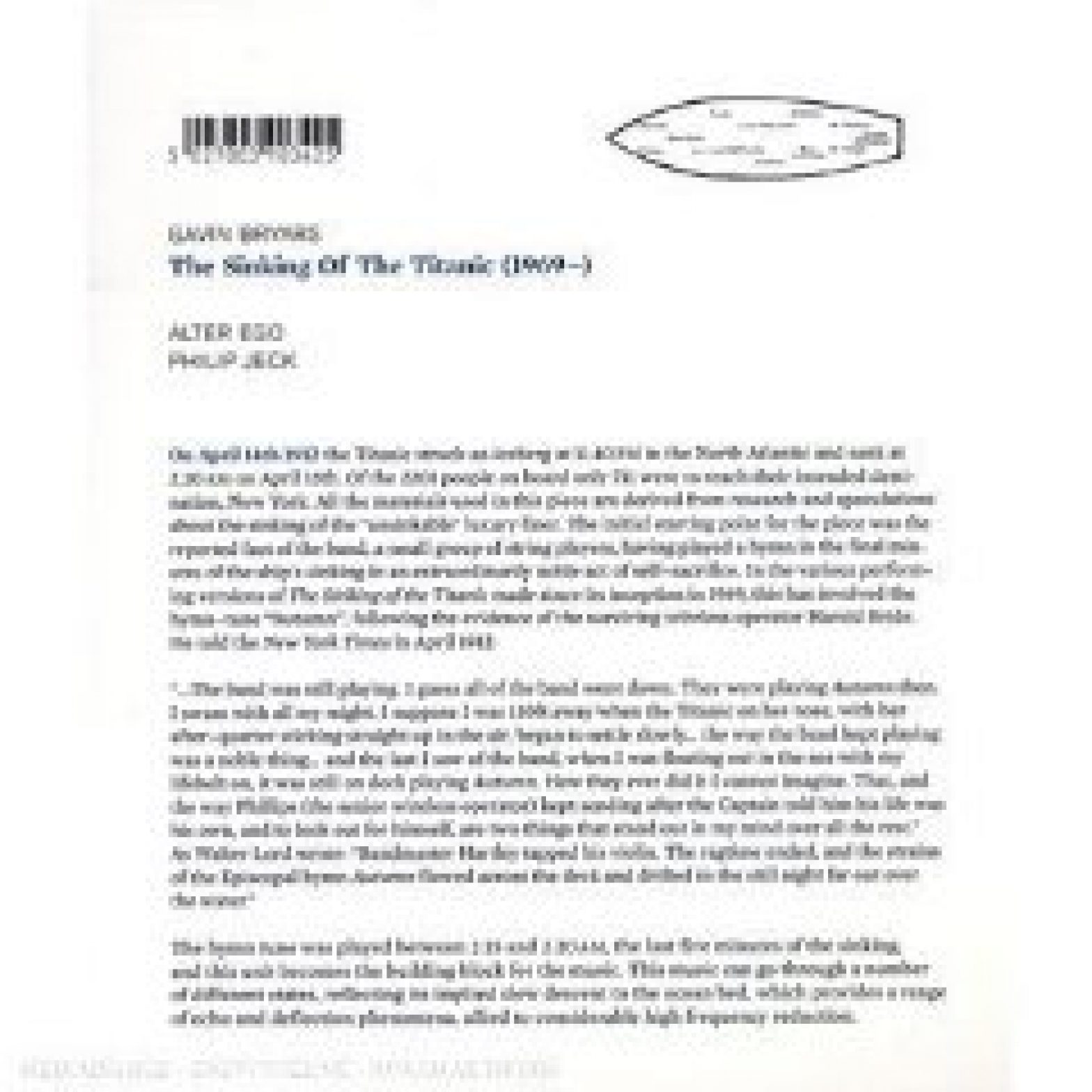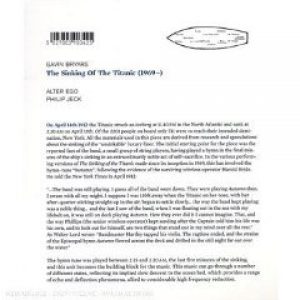Touch Records
Gavin’s Notes:
The Sinking of the Titanic (1969-)
On April 14th 1912 the Titanic struck an iceberg at 11.40 PM in the North Atlantic and sank at 2.20 AM on April 15th. Of the 2201 people on board only 711 were to reach their intended destination, New York. All the materials used in this piece are derived from research and speculations about the sinking of the “unsinkable” luxury liner. The initial starting point for the piece was the reported fact of the band, a small group of string players, having played a hymn in the final minutes of the ship’s sinking in an extraordinarily noble act of self-sacrifice. In the various performing versions of The Sinking of the Titanic made since its inception in 1969, this has involved the hymn-tune “Autumn,” following the evidence of the surviving wireless operator Harold Bride. He told the New York Times in April 1912:
“….the band was still playing. I guess all of the band went down. They were playing Autumn then. I swam with all my might. I suppose I was 150 feet away when the Titanic on her nose, with her after-quarter sticking straight up in the air, began to settle – slowly…..the way the band kept playing was a noble thing…..and the last I saw of the band, when I was floating out in the sea with my lifebelt on, it was still on deck playing Autumn. How they ever did it I cannot imagine. That, and the way Phillips (the senior wireless operator) kept sending after the Captain told him his life was his own, and to look out for himself, are two things that stand out in my mind over all the rest.”
As Walter Lord wrote: “Bandmaster Hartley tapped his violin. The ragtime ended, and the strains of the Episcopal hymn Autumn flowed across the deck and drifted in the still night far out over the water.”
The hymn tune was played between 2.15 and 2.20 am, the last five minutes of the sinking, and this unit becomes the building block for the music. This music can go through a number of different states, reflecting its implied slow descent to the ocean bed, which provides a range of echo and deflection phenomena, allied to considerable high frequency reduction. Given the ‘ceiling’ effect of the water’s surface, and the greater efficiency of water as an acoustic medium, the music may continue indefinitely beneath the sea. This presupposes that the music was played as the water engulfed the ship and, from Bride’s account, there is no reason not to think this. Remember that the band were not only playing ultimately in water, but also with the ship standing almost perpendicular in the water for these last 5 minutes. Bride could not imagine “how they ever did it”. But we know that the band was playing outside the gymnasium doors, and these formerly vertical open doors would have become the horizontal floor that served as their last bandstand (in the ship’s vertical configuration).
Apart from the equipment operated by the two wireless officers – Phillips sending, Bride receiving – there were other examples of the transmission and reception of acoustic signals. There is, for example, a technical illustration of an audio transducer attached to the hull of the ship, on the inside shell nestled against the ship’s frame. This was to enable the ship to hear underwater bells, which were attached to floating buoys out at sea along the east coast of Canada and the United States to warn of the approaching coast (the approaching iceberg was, of course, notoriously silent).
It is impossible to underestimate the importance of the great Italian Guglielmo Marconi in the tragedy. Marconi had developed the principles of wireless telegraphy over great distances and he had made the first transatlantic transmission of a signal (the letter “S”) only ten years earlier (from Poldhu in Cornwall to St Johns in Newfoundland). This, however, was the first extensive use of wireless in ocean rescue and the log of signals to and from the ship chronicle the whole progress of events. One of the survivors, drifting in the open sea, even expressed the somewhat mystical wish that they might be able to “Marconi” their gratitude to him from the lifeboat. And in fact, when Bride arrived in New York on the Carpathia, Marconi was waiting to rush on board and shake his hand.
The prolongation of the music into eternity, however, comes about from another “scientific” point of view. Towards the end of his life, Marconi became convinced that sounds once generated never die, they simply become fainter and fainter until we can no longer perceive them. Marconi’s hope was to develop sufficiently sensitive equipment, extraordinarily powerful and selective filters I suppose, to pick and hear these past, faint sounds. Ultimately he hoped to be able to hear Christ delivering the Sermon on the Mount. Curiously enough one of the rescue ships, the Birma, received radio signals, apparently originating from the Titanic, 1 hour and 28 minutes after the ship had finally gone beneath the waves.
It is perhaps fitting, therefore, that this recording of The Sinking of the Titanic should have taken place in Marconi’s native country and, moreover, in a live performance at the Teatro Malibran in one of the supreme aquatic environments, Venice. Curiously this theatre was built on the site of the home of one of the world’s greatest travellers, Marco Polo….
Gavin Bryars, October 2006
Performers:
Tracks:
2. Time - Bryars, Gavin & Philip Jeck/Alter Ego
3. Day 6 Entry 12 - Bryars, Gavin & Philip Jeck/Alter Ego
4. Rogue Frequency - Bryars, Gavin & Philip Jeck/Alter Ego/Fyza
5. Cottonmouth - Bryars, Gavin & Philip Jeck/Alter Ego/Mark De Clive-Lowe
6. Bare Knuckle - Bryars, Gavin & Philip Jeck/Alter Ego/Broke 'n' English
7. Horrorzone - Bryars, Gavin & Philip Jeck/Alter Ego/Ink Lined Minds
8. Smile Witin - Bryars, Gavin & Philip Jeck/Alter Ego/Fyza
9. Day 7 Entry 19 - Bryars, Gavin & Philip Jeck/Alter Ego
10. Givin' It Up - Bryars, Gavin & Philip Jeck/Alter Ego/Pete Simpson
11. Complicated - Bryars, Gavin & Philip Jeck/Alter Ego/Fyza
12. Day 8 Entry 21 - Bryars, Gavin & Philip Jeck/Alter Ego
13. Recognizable Forms - Bryars, Gavin & Philip Jeck/Alter Ego/Broke 'n' English/InkLined Minds
14. Experimentation - Bryars, Gavin & Philip Jeck/Alter Ego/Jenna G
15. Motion - Bryars, Gavin & Philip Jeck/Alter Ego/Broke 'n' English
16. Day 14 Entry 34 - Bryars, Gavin & Philip Jeck/Alter Ego
17. Can You Let Go - Bryars, Gavin & Philip Jeck/Alter Ego/Ink Lined Minds
18. Day 23 Entry 56 - Bryars, Gavin & Philip Jeck/Alter Ego
19. Secondary Power - Bryars, Gavin & Philip Jeck/Alter Ego/Pete Simpson/Jenna G
20. Day 30 Entry 72 - Bryars, Gavin & Philip Jeck/Alter Ego

